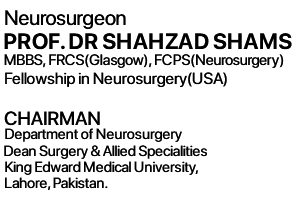Parkinson’s Disease Treatment with DBS Surgery Prof Shahzad Shams
Prof. Shahzad Shams worked as Head and Professor of Neurosurgery Department at Lahore General Hospital, LGH, Lahore, Pakistan and presently works as Chairman Department of Neurosurgery King Edward Medical University and Mayo Hospital, Lahore, Pakistan.
Prof Shahzad Shams excels in all kinds of treatments required for diseases like Parkinson’s disease, Essential tremors and Dystonia. He is the best Neurosurgeon for the treatment of movement disorders and considered the best among the Doctors, Neur physicians, Medical Specialists and General Physicians.
Prof Shahzad Shams is one of the Pioneers of DBS Deep Brain Stimulation surgery for Parkinson’s disease, Dystonia and other movement disorders in Pakistan and is referred to cases from abroad also.
He is the first in Pakistan to start DBS surgery in the Private sector at Omar Hospital, Lahore, Pakistan. He is the best neurosurgeon for DBS Deep Brain Stimulation Surgery for Parkinson’s Disease in Pakistan and Asia.
DBS Deep Brain Stimulation-Surgery for Movement Disorders
Prof Shahzad Shams is the best Neurosurgeon for the treatment with most latest and Advanced techniques for Movement Disorders, Parkinson’s Disease, Essential Tremors, Dystonia, Writer’s cramp, Obsessive-compulsive disorder OCD, Tourette’s Syndrome, Epilepsy, Major Depression and Coma with DBS Deep Brain Stimulation Surgery in Lahore, Pakistan.
Programming after deep brain stimulation is a very specialized process for which Prof Shahzad Shams is the best in Pakistan. Best Neurosurgeon for treatment and DBS deep brain stimulation surgery for Parkinson’s disease, Essential Tremors, and Dystonia in Lahore, Pakistan. Prof Shams’s Movement Disorder Clinic is the most comprehensive and has a robust program for the treatment of Parkinson’s disease, Tremors, and Dystonia in Pakistan.
Parkinson’s Disease
Parkinson’s disease symptoms, including tremor, stiffness of the limbs, gradual loss of spontaneous movement, decreased mental skills or reaction time, voice changes, decreased facial expression, gradual loss of automatic movement, decreased blinking, decreased frequency of swallowing, and drooling; a stooped, flexed posture, with bending at the elbows, knees, and hips; an unsteady walk or balance; and memory loss with depression.
Deep Brain Stimulation or DBS Procedure
DBS surgery involves putting the tip of a hair-thin wire inside the brain in a special area that controls movement. The patient is awake during surgery to allow the surgical team to assess the patient’s brain functions. The small wire runs up through a small hole in the skull and under the scalp, down to a small device implanted under the collarbone. Local anesthetic is applied to these areas, and the patient is occasionally sedated.
While the electrode is being advanced through the brain, the patient does not feel any pain. Most patients have two implants — one on each side of the brain.
Steps of Procedure
- Patient Evaluation by Neuro physician
- Patient eligibility for DBS by ANFN team
- Hospital admission
Surgical Steps
- Pre-op imaging
- Application of stereotactic frame
- Imaging with frame
- Surgical planning and localization of target radiologically
- Burr hole under local analgesia
- Physiological confirmation of target by MER
- Implantation of electrodes in the brain
- Implantation of battery (IPG) in front of chest
- Programming of DBS to obtain best results
How DBS or Deep Brain Stimulation Works?
Deep brain stimulation (DBS), or Electric subcortical stimulation, illustrates functional Neurosurgical intervention with Stereotactic placement of Electrodes into Target brain regions. Propagating from an external stimulation device, which becomes internalized via subdermal implantation.
Electric impulses traverse the electrodes, stimulating the desired target and invoking therapeutic responses within the patient giving Miraculous cure from all the diseases listed above. The whole procedure is performed in awake patient and they are discharged the next day.






